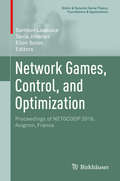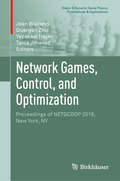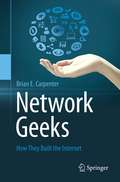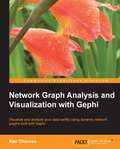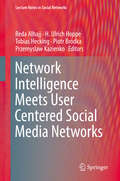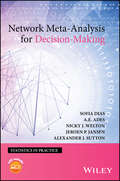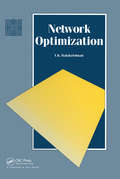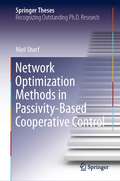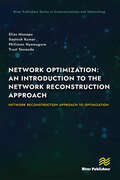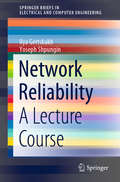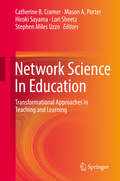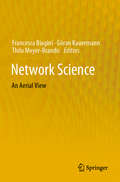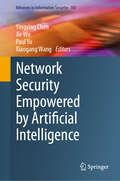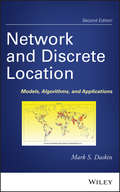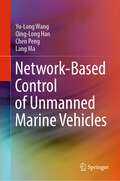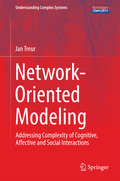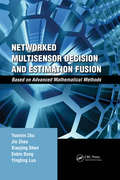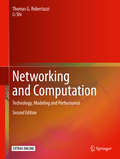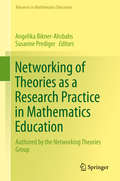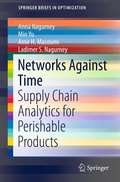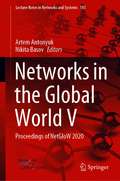- Table View
- List View
Network Games, Control, and Optimization
by Eilon Solan Samson Lasaulce Tania JimenezThis contributed volume offers a collection of papers presented at the 2016 Network Games, Control, and Optimization conference (NETGCOOP), held at the University of Avignon in France, November 23-25, 2016. These papers highlight the increasing importance of network control and optimization in many networking application domains, such as mobile and fixed access networks, computer networks, social networks, transportation networks, and, more recently, electricity grids and biological networks. Covering a wide variety of both theoretical and applied topics in the areas listed above, the authors explore several conceptual and algorithmic tools that are needed for efficient and robust control operation, performance optimization, and better understanding the relationships between entities that may be acting cooperatively or selfishly in uncertain and possibly adversarial environments. As such, this volume will be of interest to applied mathematicians, computer scientists, engineers, and researchers in other related fields.
Network Games, Control, and Optimization: Proceedings Of Netgcoop 2016, Avignon, France (Static & Dynamic Game Theory: Foundations & Applications)
by Quanyan Zhu Tania Jimenez Jean Walrand Yezekael HayelThis contributed volume offers a collection of papers presented at the 2016 Network Games, Control, and Optimization conference (NETGCOOP), held at the University of Avignon in France, November 23-25, 2016. These papers highlight the increasing importance of network control and optimization in many networking application domains, such as mobile and fixed access networks, computer networks, social networks, transportation networks, and, more recently, electricity grids and biological networks. Covering a wide variety of both theoretical and applied topics in the areas listed above, the authors explore several conceptual and algorithmic tools that are needed for efficient and robust control operation, performance optimization, and better understanding the relationships between entities that may be acting cooperatively or selfishly in uncertain and possibly adversarial environments. As such, this volume will be of interest to applied mathematicians, computer scientists, engineers, and researchers in other related fields.
Network Geeks
by Brian E CarpenterThe impact on modern society made by the Internet is immeasurable. Yet some questioned "why anyone would want such a thing" when the idea was first introduced. Part history, part memoir and part cultural study, Network Geeks charts the creation of the Internet and the establishment of the Internet Engineering Task Force, from the viewpoint of a self-proclaimed geek who witnessed these developments first-hand. With boundless enthusiasm and abundant humour, Brian Carpenter leads the reader on a journey from post-war Britain to post-millennium New Zealand, describing how the Internet grew into today's ubiquitous, global network, including the genesis of the World-Wide Web in the hotbeds of a particle collider at CERN. Illuminating the science and technology behind the apparent "magic trick" of the Internet, Network Geeks opens a window into the initially bewildering world of the Internet engineering geek. After reading this book, you may wish to join this world yourself.
Network Graph Analysis and Visualization with Gephi
by Ken ChervenA practical, hands-on guide, that provides you with all the tools you need to visualize and analyze your data using network graphs with Gephi.This book is for data analysts who want to intuitively reveal patterns and trends, highlight outliers, and tell stories with their data using Gephi. It is great for anyone looking to explore interactions within network datasets, whether the data comes from social media or elsewhere. It is also a valuable resource for those seeking to learn more about Gephi without being overwhelmed by technical details.
Network Intelligence Meets User Centered Social Media Networks (Lecture Notes in Social Networks)
by Reda Alhajj H. Ulrich Hoppe Tobias Hecking Piotr Bródka Przemyslaw KazienkoThis edited volume presents advances in modeling and computational analysis techniques related to networks and online communities. It contains the best papers of notable scientists from the 4th European Network Intelligence Conference (ENIC 2017) that have been peer reviewed and expanded into the present format. The aim of this text is to share knowledge and experience as well as to present recent advances in the field. The book is a nice mix of basic research topics such as data-based centrality measures along with intriguing applied topics, for example, interaction decay patterns in online social communities. This book will appeal to students, professors, and researchers working in the fields of data science, computational social science, and social network analysis.
Network Meta-Analysis for Decision-Making
by A. E. Ades Nicky J. Welton Alexander J. Sutton Sofia Dias Jeroen P. JansenA practical guide to network meta-analysis with examples and code In the evaluation of healthcare, rigorous methods of quantitative assessment are necessary to establish which interventions are effective and cost-effective. Often a single study will not provide the answers and it is desirable to synthesise evidence from multiple sources, usually randomised controlled trials. This book takes an approach to evidence synthesis that is specifically intended for decision making when there are two or more treatment alternatives being evaluated, and assumes that the purpose of every synthesis is to answer the question “for this pre-identified population of patients, which treatment is ‘best’?” A comprehensive, coherent framework for network meta-analysis (mixed treatment comparisons) is adopted and estimated using Bayesian Markov Chain Monte Carlo methods implemented in the freely available software WinBUGS. Each chapter contains worked examples, exercises, solutions and code that may be adapted by readers to apply to their own analyses. This book can be used as an introduction to evidence synthesis and network meta-analysis, its key properties and policy implications. Examples and advanced methods are also presented for the more experienced reader. Methods used throughout this book can be applied consistently: model critique and checking for evidence consistency are emphasised. Methods are based on technical support documents produced for NICE Decision Support Unit, which support the NICE Methods of Technology Appraisal. Code presented is also the basis for the code used by the ISPOR Task Force on Indirect Comparisons. Includes extensive carefully worked examples, with thorough explanations of how to set out data for use in WinBUGS and how to interpret the output. Network Meta-Analysis for Decision Making will be of interest to decision makers, medical statisticians, health economists, and anyone involved in Health Technology Assessment including the pharmaceutical industry.
Network Optimization
by V. BalakrishnanProblems in network optimization arise in all areas of technology and industrial management. The topic of network flows has applications in diverse fields such as chemistry, engineering, management science, scheduling and transportation, to name a few. Network Optimization introduces the subject to undergraduate and graduate students in computer science, mathematics and operations research. The focus is mainly on developing the mathematical underpinnings of the techniques that make it possible to solve the several optimization problems covered in the text. The text discusses such topics as optimal branching problems, transshipment problems, shortest path problems, minimum cost flow problems, maximum flow problems, matching in bipartite and nonbipartite graphs and many applications to combinatorics. Also included is a large number of exercises.
Network Optimization Methods in Passivity-Based Cooperative Control (Springer Theses)
by Miel SharfThis book establishes an important mathematical connection between cooperative control problems and network optimization problems. It shows that many cooperative control problems can in fact be understood, under certain passivity assumptions, using a pair of static network optimization problems. Merging notions from passivity theory and network optimization, it describes a novel network optimization approach that can be applied to the synthesis of controllers for diffusively-coupled networks of passive (or passivity-short) dynamical systems. It also introduces a data-based, model-free approach for the synthesis of network controllers for multi-agent systems with passivity-short agents. Further, the book describes a method for monitoring link faults in multi-agent systems using passivity theory and graph connectivity. It reports on some practical case studies describing the effectivity of the developed approaches in vehicle networks. All in all, this book offers an extensive source of information and novel methods in the emerging field of multi-agent cooperative control, paving the way to future developments of autonomous systems for various application domains
Network Optimization: Network Reconstruction Approach to optimization (River Publishers Series in Communications and Networking)
by Santosh Kumar Elias Munapo Philimon Nyamugure Trust TawandaFor every problem, mathematical or otherwise, there is more than one approach and much depends on the ingenuity of the person concerned. Consider that a person is interested in picking some fruit from a tree and is considering multiple picking options. One possibility is, if one can reach the fruit, just snip it to retrieve it. The second possibility is to alternatively apply force and detach the fruit from the tree. If neither option is possible, the fruit can still be detached from the tree, but how? A third possibility lies in the fact that just holding on to the fruit and turning it in one direction it can be picked. Similarly, many possibilities are seen by keen eyes while solving a mathematical problem. The reconstruction approach applied in this book is like the third possibility of holding a fruit and turning it in one direction until the desired solution is obtained.This book is an introduction to reconstruction concepts and their applications for solving some network optimization problems. Networks are a mathematical abstraction of a given physical situation, which are described by using nodes, links (directed or non-directed) and link weights defining some associated properties of that physical system. Reconstruction ideas exploit the mathematical structure of a particular problem and find ways to reach the required solution. It is hoped that these ideas will be explored for other mathematical structures.The authors have developed many methods to find optimal solutions for these network related problems and they observed that various methods discussed in 8 chapters have a common thread of reconstruction, which unites them, and that aspect motivated authors to develop this book.
Network Reliability: A Lecture Course (SpringerBriefs in Electrical and Computer Engineering)
by Ilya Gertsbakh Yoseph ShpunginThis introductory book equips the reader to apply the core concepts and methods of network reliability analysis to real-life problems. It explains the modeling and critical analysis of systems and probabilistic networks, and requires only a minimal background in probability theory and computer programming. Based on the lecture notes of eight courses taught by the authors, the book is also self-contained, with no theory needed beyond the lectures. The primary focus is on essential “modus operandi,” which are illustrated in numerous examples and presented separately from the more difficult theoretical material.
Network Science
by Desmond J. Higham Gian-Luca Oppo Ernesto Estrada Maria FoxNetwork Science is the emerging field concerned with the study of large, realistic networks. This interdisciplinary endeavor, focusing on the patterns of interactions that arise between individual components of natural and engineered systems, has been applied to data sets from activities as diverse as high-throughput biological experiments, online trading information, smart-meter utility supplies, and pervasive telecommunications and surveillance technologies. This unique text/reference provides a fascinating insight into the state of the art in network science, highlighting the commonality across very different areas of application and the ways in which each area can be advanced by injecting ideas and techniques from another. The book includes contributions from an international selection of experts, providing viewpoints from a broad range of disciplines. It emphasizes networks that arise in nature--such as food webs, protein interactions, gene expression, and neural connections--and in technology--such as finance, airline transport, urban development and global trade. Topics and Features: begins with a clear overview chapter to introduce this interdisciplinary field; discusses the classic network science of fixed connectivity structures, including empirical studies, mathematical models and computational algorithms; examines time-dependent processes that take place over networks, covering topics such as synchronisation, and message passing algorithms; investigates time-evolving networks, such as the World Wide Web and shifts in topological properties (connectivity, spectrum, percolation); explores applications of complex networks in the physical and engineering sciences, looking ahead to new developments in the field. Researchers and professionals from disciplines as varied as computer science, mathematics, engineering, physics, chemistry, biology, ecology, neuroscience, epidemiology, and the social sciences will all benefit from this topical and broad overview of current activities and grand challenges in the unfolding field of network science.
Network Science In Education: Transformational Approaches in Teaching and Learning
by Mason A. Porter Hiroki Sayama Catherine B. Cramer Lori Sheetz Stephen Miles UzzoAround the globe, there is an increasingly urgent need to provide opportunities for learners to embrace complexity; to develop the many skills and habits of mind that are relevant to today's complex and interconnected world; and to make learning more connected to our rapidly changing workplace and society. This presents an opportunity to (1) leverage new paradigms for understanding the structure and function of teaching and learning communities, and (2) to promote new approaches to developing methods, curricular materials, and resources. Network science - the study of connectivity - can play an important role in these activities, both as an important subject in teaching and learning and as a way to develop interconnected curricula. Since 2010, an international community of network science researchers and educators has come together to raise the global level of network literacy by applying ideas from network science to teaching and learning. Network Science in Education - which refers to both this community and to its activities - has evolved in response to the escalating activity in the field of network science and the need for people to be able to access the field through education channels. Network Science In Education: Transformational Approaches in Teaching and Learning appeals to both instructors and professionals, while offering case studies from a wide variety of activities that have been developed around the globe: the creation of entirely new courses and degree programs; tools for K-20 learners, teachers, and the general public; and in-depth analysis of selected programs. As network-based pedagogy and the community of practice continues to grow, we hope that the book's readers will join this vibrant network education community to build on these nascent ideas and help deepen the understanding of networks for all learners.
Network Science: An Aerial View
by Francesca Biagini Göran Kauermann Thilo Meyer-BrandisThis book provides an overview of network science from the perspective of diverse academic fields, offering insights into the various research areas within network science. The authoritative contributions on statistical network analysis, mathematical network science, genetic networks, Bayesian networks, network visualisation, and systemic risk in networks explore the main questions in the respective fields: What has been achieved to date? What are the research challenges and obstacles? What are the possible interconnections with other fields? And how can cross-fertilization between these fields be promoted? Network science comprises numerous scientific disciplines, including computer science, economics, mathematics, statistics, social sciences, bioinformatics, and medicine, among many others. These diverse research areas require and use different data-analytic and numerical methods as well as different theoretical approaches. Nevertheless, they all examine and describe interdependencies, associations, and relationships of entities in different kinds of networks. The book is intended for researchers as well as interested readers working in network science who want to learn more about the field – beyond their own research or work niche. Presenting network science from different perspectives without going into too much technical detail, it allows readers to gain an overview without having to be a specialist in any or all of these disciplines.
Network Science: Analysis and Optimization Algorithms for Real-World Applications
by Carlos Andre PinheiroNetwork Science Network Science offers comprehensive insight on network analysis and network optimization algorithms, with simple step-by-step guides and examples throughout, and a thorough introduction and history of network science, explaining the key concepts and the type of data needed for network analysis, ensuring a smooth learning experience for readers. It also includes a detailed introduction to multiple network optimization algorithms, including linear assignment, network flow and routing problems. The text is comprised of five chapters, focusing on subgraphs, network analysis, network optimization, and includes a list of case studies, those of which include influence factors in telecommunications, fraud detection in taxpayers, identifying the viral effect in purchasing, finding optimal routes considering public transportation systems, among many others. This insightful book shows how to apply algorithms to solve complex problems in real-life scenarios and shows the math behind these algorithms, enabling readers to learn how to develop them and scrutinize the results. Written by a highly qualified author with significant experience in the field, Network Science also includes information on: Sub-networks, covering connected components, bi-connected components, community detection, k-core decomposition, reach network, projection, nodes similarity and pattern matching Network centrality measures, covering degree, influence, clustering coefficient, closeness, betweenness, eigenvector, PageRank, hub and authority Network optimization, covering clique, cycle, linear assignment, minimum-cost network flow, maximum network flow problem, minimum cut, minimum spanning tree, path, shortest path, transitive closure, traveling salesman problem, vehicle routing problem and topological sort With in-depth and authoritative coverage of the subject and many case studies to convey concepts clearly, Network Science is a helpful training resource for professional and industry workers in, telecommunications, insurance, retail, banking, healthcare, public sector, among others, plus as a supplementary reading for an introductory Network Science course for undergraduate students.
Network Security Empowered by Artificial Intelligence (Advances in Information Security #107)
by Yingying Chen Jie Wu Paul Yu Xiaogang WangThis book introduces cutting-edge methods on security in spectrum management, mobile networks and next-generation wireless networks in the era of artificial intelligence (AI) and machine learning (ML). This book includes four parts: (a) Architecture Innovations and Security in 5G Networks, (b) Security in Artificial Intelligence-enabled Intrusion Detection Systems. (c) Attack and Defense in Artificial Intelligence-enabled Wireless Systems, (d) Security in Network-enabled Applications. The first part discusses the architectural innovations and security challenges of 5G networks, highlighting novel network structures and strategies to counter vulnerabilities. The second part provides a comprehensive analysis of intrusion detection systems and the pivotal role of AI and machine learning in defense and vulnerability assessment. The third part focuses on wireless systems, where deep learning is explored to enhance wireless communication security. The final part broadens the scope, examining the applications of these emerging technologies in network-enabled fields.The advancement of AI/ML has led to new opportunities for efficient tactical communication and network systems, but also new vulnerabilities. Along this direction, innovative AI-driven solutions, such as game-theoretic frameworks and zero-trust architectures are developed to strengthen defenses against sophisticated cyber threats. Adversarial training methods are adopted to augment this security further. Simultaneously, deep learning techniques are emerging as effective tools for securing wireless communications and improving intrusion detection systems. Additionally, distributed machine learning, exemplified by federated learning, is revolutionizing security model training. Moreover, the integration of AI into network security, especially in cyber-physical systems, demands careful consideration to ensure it aligns with the dynamics of these systems.This book is valuable for academics, researchers, and students in AI/ML, network security, and related fields. It serves as a resource for those in computer networks, AI, ML, and data science, and can be used as a reference or secondary textbook.
Network Theory and Agent-Based Modeling in Economics and Finance
by Anindya S. Chakrabarti Lukáš Pichl Taisei KaizojiThis book presents the latest findings on network theory and agent-based modeling of economic and financial phenomena. In this context, the economy is depicted as a complex system consisting of heterogeneous agents that interact through evolving networks; the aggregate behavior of the economy arises out of billions of small-scale interactions that take place via countless economic agents. The book focuses on analytical modeling, and on the econometric and statistical analysis of the properties emerging from microscopic interactions. In particular, it highlights the latest empirical and theoretical advances, helping readers understand economic and financial networks, as well as new work on modeling behavior using rich, agent-based frameworks. Innovatively, the book combines observational and theoretical insights in the form of networks and agent-based models, both of which have proved to be extremely valuable in understanding non-linear and evolving complex systems. Given its scope, the book will capture the interest of graduate students and researchers from various disciplines (e.g. economics, computer science, physics, and applied mathematics) whose work involves the domain of complexity theory.
Network and Discrete Location
by Mark S. DaskinPraise for the First EditionThis book is refreshing to read since it takes an important topic... and presents it in a clear and concise manner by using examples that include visual presentations of the problem, solution methods, and results along with an explanation of the mathematical and procedural steps required to model the problem and work through to a solution." --Journal of ClassificationThoroughly updated and revised, Network and Discrete Location: Models, Algorithms, and Applications, Second Edition remains the go-to guide on facility location modeling. The book offers a unique introduction to methodological tools for solving location models and provides insight into when each approach is useful and what information can be obtained.The Second Edition focuses on real-world extensions of the basic models used in locating facilities, including production and distribution systems, location-inventory models, and defender-interdictor problems. A unique taxonomy of location problems and models is also presented. Featuring examples using the author's own software--SITATION, MOD-DIST, and MENU-OKF--as well as Microsoft Office® Excel®, the book provides: * A theoretical and applied perspective on location models and algorithms* An intuitive presentation of the uses and limits of modeling techniques* An introduction to integrated location-inventory modeling and defender-interdictor models for the design of reliable facility location systems* A full range of exercises to equip readers with an understanding of the basic facility location model types Network and Discrete Location: Models, Algorithms, and Applications, Second Edition is an essential resource for practitioners in applied and discrete mathematics, operations research, industrial engineering, and quantitative geography. The book is also a useful textbook for upper-level undergraduate, graduate, and MBA courses.
Network-Based Control of Unmanned Marine Vehicles
by Chen Peng Qing-Long Han Yu-Long Wang Lang MaThis book presents a comprehensive analysis of stability, stabilization, and fault detection in networked control systems, with a focus on unmanned marine vehicles. It investigates the challenges of network-based control in areas like heading control, fault detection filter and controller design, dynamic positioning, and cooperative target tracking. Communication networks in control systems can induce delays and dropouts, so the book presents the importance of stability analysis, stabilize, and fault detection. To help readers gain a deeper understanding of these concepts, the book provides fundamental concepts and real-world examples. This book is a valuable resource for researchers and practitioners working in the field of network-based control for unmanned marine vehicles.
Network-Oriented Modeling
by Jan TreurThis book presents a new approach that can be applied to complex, integrated individual and social human processes. It provides an alternative means of addressing complexity, better suited for its purpose than and effectively complementing traditional strategies involving isolation and separation assumptions. Network-oriented modeling allows high-level cognitive, affective and social models in the form of (cyclic) graphs to be constructed, which can be automatically transformed into executable simulation models. The modeling format used makes it easy to take into account theories and findings about complex cognitive and social processes, which often involve dynamics based on interrelating cycles. Accordingly, it makes it possible to address complex phenomena such as the integration of emotions within cognitive processes of all kinds, of internal simulations of the mental processes of others, and of social phenomena such as shared understandings and collective actions. A variety of sample models - including those for ownership of actions, fear and dreaming, the integration of emotions in joint decision-making based on empathic understanding, and evolving social networks - illustrate the potential of the approach. Dedicated software is available to support building models in a conceptual or graphical manner, transforming them into an executable format and performing simulation experiments. The majority of the material presented has been used and positively evaluated by undergraduate and graduate students and researchers in the cognitive, social and AI domains. Given its detailed coverage, the book is ideally suited as an introduction for graduate and undergraduate students in many different multidisciplinary fields involving cognitive, affective, social, biological, and neuroscience domains.
Networked Multisensor Decision and Estimation Fusion: Based on Advanced Mathematical Methods
by Jie Zhou Yunmin Zhu Xiaojing Shen Enbin Song Yingting LuoDue to the increased capability, reliability, robustness, and survivability of systems with multiple distributed sensors, multi-source information fusion has become a crucial technique in a growing number of areas-including sensor networks, space technology, air traffic control, military engineering, agriculture and environmental engineering, and i
Networking and Computation: Technology, Modeling and Performance
by Li Shi Thomas G. RobertazziThis useful volume adopts a balanced approach between technology and mathematical modeling in computer networks, covering such topics as switching elements and fabrics, Ethernet, and ALOHA design. The discussion includes a variety of queueing models, routing, protocol verification and error codes and divisible load theory, a new modeling technique with applications to grids and parallel and distributed processing. Examples at the end of each chapter provide ample material for practice. This book can serve as an text for an undergraduate or graduate course on computer networks or performance evaluation in electrical and computer engineering or computer science.
Networking of Theories as a Research Practice in Mathematics Education
by Angelika Bikner-Ahsbahs Susanne PredigerHow can we deal with the diversity of theories in mathematics education? This was the main question that led the authors of this book to found the Networking Theories Group. Starting from the shared assumption that the existence of different theories is a resource for mathematics education research, the authors have explored the possibilities of interactions between theories, such as contrasting, coordinating, and locally integrating them. The book explains and illustrates what it means to network theories; it presents networking as a challenging but fruitful research practice and shows how the Group dealt with this challenge considering five theoretical approaches, namely the approach of Action, Production, and Communication (APC), the Theory of Didactical Situations (TDS), the Anthropological Theory of the Didactic (ATD), the approach of Abstraction in Context (AiC), and the Theory of Interest-Dense Situations (IDS). A synthetic presentation of each theory and their connections shows how the activity of networking generates questions at the theoretical, methodological and practical levels and how the work on these questions leads to both theoretical and practical progress. The core of the book consists of four new networking case studies which illustrate what exactly can be gained by this approach and what kind of difficulties might arise.
Networks Against Time
by Ladimer S. Nagurney Anna Nagurney Min Yu Amir H. MasoumiDespite significant achievements, the discipline of supply chain management is still unable to satisfactorily handle many practical real-world challenges. The authors of Networks Against Time claim that a unified supply chain network analytics framework is needed which should be able to handle optimization and competitive behavior while also maintain relevance to many industrial sectors in which perishable products are prominent, from healthcare to food and from fashion apparel to technology. This Brief provides a wide range of critical supply chain problems which are modeled as generalized networks. Guidelines are provided to determine the arc multipliers that capture perish ability of the product whether food, radioisotopes, or even highly perishable blood in healthcare over space and time. Through case studies the authors portray the application of the models and algorithms to real-world sectors which illustrate the power of the framework in practice. The models and algorithms are fully described along with the input and output data in the case studies. This level of transparency is useful pedagogically as well as for future research and for applications in practice. Researchers and practitioners in mathematics, in operations research and management science, operations management, as well as in economics and computer science will find this book useful to gain a broader appreciation of the richness of network supply chain structures, processes, and applications. This book can also be used by advanced undergraduate students and graduate students in the disciplines noted above to familiarize themselves with methodologies and supply chain network models and applications.
Networks in the Global World V: Proceedings of NetGloW 2020 (Lecture Notes in Networks and Systems #181)
by Artem Antonyuk Nikita BasovThis proceedings book presents state-of-the-art developments in theory, methodology, and applications of network analysis across sociology, computational science, education research, literature studies, political science, international relations, social media research, and urban studies. The papers comprising this collection were presented at the Fifth ‘Networks in the Global World’ conference organized by the Centre for German and European Studies of St. Petersburg University and Bielefeld University and held on July 7–9, 2020. This biannual conference series revolves around key interdisciplinary issues in the focus of network analysts, such as the multidimensional approach to social reality, translation of theories and methods across disciplines, and mixing of data and methods. The distinctive features of this book are the emphasis on in-depth linkages between theory, method, and applications, the blend of qualitative and quantitative methods, and the joint consideration of different network levels, types, and contexts. The topics covered by the papers include interrelation of social and cultural structures, constellations of power, and patterns of interaction in areas ranging from various types of communities (local, international, educational, political, and so on) to social media and literature. The book is useful for practicing researchers, graduate and postgraduate students, and educators interested in network analysis of social relations, politics, economy, and culture. Features that set the book apart from others in the field: · The book offers a unique cross-disciplinary blend of computational and ethnographic network analyses applied to a diverse spectrum of spheres, from literature and education to urban planning and policymaking. · Embracing conceptual, methodological, and empirical works, the book is among the few in network analysis to emphasize connections between theory, method, and applications. · The book brings together authors and empirical contexts from all over the globe, with a particular emphasis on European societies.
Networks of Echoes
by Bruce J. West Malgorzata Turalska Paolo GrigoliniNetworks of Echoes: Imitation, Innovation and Invisible Leaders is a mathematically rigorous and data rich book on a fascinating area of the science and engineering of social webs. There are hundreds of complex network phenomena whose statistical properties are described by inverse power laws. The phenomena of interest are not arcane events that we encounter only fleetingly, but are events that dominate our lives. We examine how this intermittent statistical behavior intertwines itself with what appears to be the organized activity of social groups. The book is structured as answers to a sequence of questions such as: How are decisions reached in elections and boardrooms? How is the stability of a society undermined by zealots and committed minorities and how is that stability re-established? Can we learn to answer such questions about human behavior by studying the way flocks of birds retain their formation when eluding a predator? These questions and others are answered using a generic model of a complex dynamic network--one whose global behavior is determined by a symmetric interaction among individuals based on social imitation. The complexity of the network is manifest in time series resulting from self-organized critical dynamics that have divergent first and second moments, are non-stationary, non-ergodic and non-Poisson. How phase transitions in the network dynamics influence such activity as decision making is a fascinating story and provides a context for introducing many of the mathematical ideas necessary for understanding complex networks in general. The decision making model (DMM) is selected to emphasize that there are features of complex webs that supersede specific mechanisms and need to be understood from a general perspective. This insightful overview of recent tools and their uses may serve as an introduction and curriculum guide in related courses.
